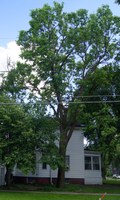Dakota Gardener: The redwoods of North Dakota
(Click an image below to view a high-resolution image that can be downloaded)
By Joe Zeleznik, Forester
NDSU Extension
Let’s face it. North Dakota does not have redwoods.
There was, however, a type of Sequoia that grew here 65 million years ago. But that doesn’t count today.
There are some pretty big trees here, though. The largest tree is a cottonwood that is 105 feet tall, with a whopping 30-foot circumference and a crown spread of 92 feet, located in Steele County.
The tallest tree is a different cottonwood that was 115 feet in height, when it was last measured in 2017. I wonder how much taller it is now?
The largest tree and the tallest tree are not one-and-the-same, which may sound confusing. Trees are complicated things and they sometimes grow in strange ways. How do we decide what is biggest?
Everything you need to know about this topic is available in the North Dakota Forest Service’s 2021 Register of Champion Trees. The Register has all of this information and more and is available online.
A formula that combines height, stem circumference and crown spread is used to rate each tree with a total number of points. The tree with the largest point value is the champion. Pretty straightforward, right? Usually.
Height is pretty straightforward. So is crown spread. Measure the spread of the crown at two places (at right angles to each other) and take the average.
Then measure the circumference of the stem. In forestry, the standard position for measuring tree circumference is 4.5 feet above the ground. While this sounds straightforward, this is where it can get tricky.
What if the stem is forked? Should it be counted as a one tree, or is it two trees?
This question has been debated many times through the years. The arguments go around and around.
For now, the standard answer is: If the tree forks below 4.5 feet, it counts as two trees. If the fork is above 4.5 feet, it counts as a single tree.
Coming back to that formula for determining total number of points:
Total points = Height (in feet) + Circumference (in inches) + ¼ Average Crown Spread (in feet)
The largest tree in North Dakota is that above-mentioned cottonwood in Steele County with a score of 488 points. The tallest cottonwood, located in Ransom County, scored 475 points. These trees are absolutely enormous!
While a number of the champions are located in eastern North Dakota, that’s not always the case.
The largest Rocky Mountain juniper is located in McKenzie County, while the runner-up is in Slope County. The largest ponderosa pine is also in Slope County.
A number of champions are located in the Turtle Mountains as well, one of the few naturally forested areas of the state.
I’ve been fortunate enough to visit a number of the champion trees throughout North Dakota. Trees located on public land can be visited at any time. If a champion is located on private property, you must get permission from the landowner before going onto their property. Fortunately, landowner information is also listed in the Register.
Nomination information is also listed in the Register. If you think a tree is big enough to qualify, go for it!
“The big trees of North Dakota." I need to use that phrase more often.
NDSU Agriculture Communication – July 26, 2022
Source: Joe Zeleznik, 701-730-3389, joseph.zeleznik@ndsu.edu
Editor: Kelli Anderson, 701-231-6136, kelli.c.anderson@ndsu.edu




